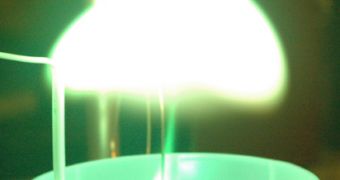When saying lightning, only one thing comes immediately to our mind, namely the image of a roughly linear electrical discharge through the Earth's atmosphere. This doesn't mean however that this is the one and only definition of a lightning. There is evidence, for example, that lightning discharges can take a number of different shapes, amongst which that of a spherical ball of light moving freely through the air. Don't take this as some kind of a myth, the phenomenon is a real as it gets, the only problem is that it occurs so rarely that scientists have not yet determined what conditions are required for the creation of such a structure.
A couple of curious researchers from the University of Rennes, in collaboration with colleagues from the Tel Aviv University and the European Synchrotron Radiation Facility in Grenoble, set up to the mammoth task of finding how ball lightning forms and burns into the atmosphere, even though there has been no previous research into the phenomenon or what would happen once the object is created.
Since no information was available, except for the fact that the discharge has a spherical shape and last only a few nanoseconds, the researchers started experimenting with plasma maintained into a rough spherical shape for a few seconds. Indeed, the conditions provided by Jerby, from the Tel Aviv University, resulted in the creation of a fireball floating in the air in laboratory conditions, relatively similar to ball lightning. According to James Brown Mitchell, the apparition of the spherical feature provided with a good opportunity of determining whether or not the plasma gas contained any nanoparticles, which would then also be contained into naturally-occurring ball lightnings.
In order to do so, however, the spherical plasma structure needed to be scanned with the help of a powerful X-ray instrument, at least 10 billion times more energetic than those traditionally used in medical imaging techniques. Thus, the experiment was moved to the European Synchrotron Radiation Facility, a particle accelerator with a circumference about one kilometer long. During the scanning procedure, the X-ray instrument clearly showed that the plasma gas contained traces of nanoparticles, leading to the conclusion that natural occurring ball lightnings should have similar characteristics.
Further still, the team accurately measured the size of the particles, distribution and decay rates. Mitchell says that the next step of the experiment will be determining the size and internal structure of the feature, and the composition of the detected nanoparticles. It seems that the particles could be producing a catalytic reaction to sustain the structure, as they heat up rather fast. More importantly, scientists are more preoccupied now with pondering what to do with the extracted information which proves that real ball lightning phenomenons take place.

 14 DAY TRIAL //
14 DAY TRIAL //